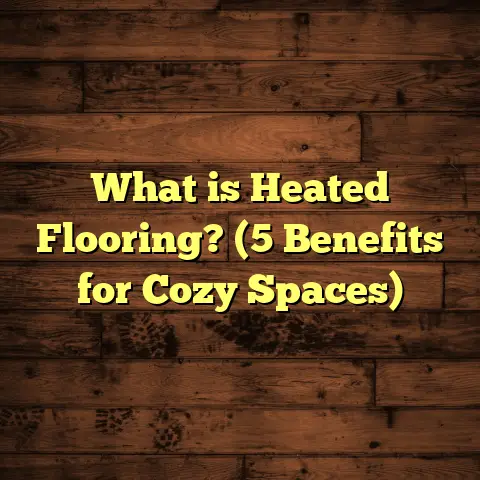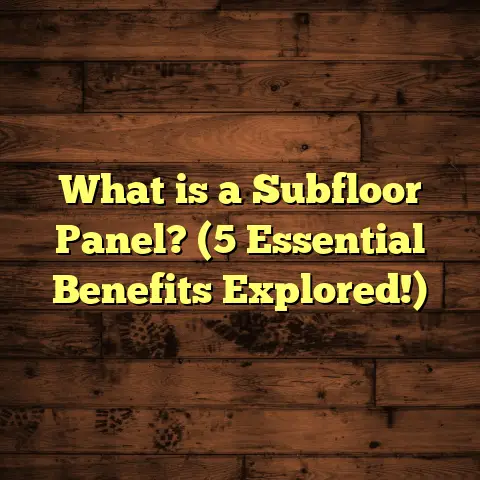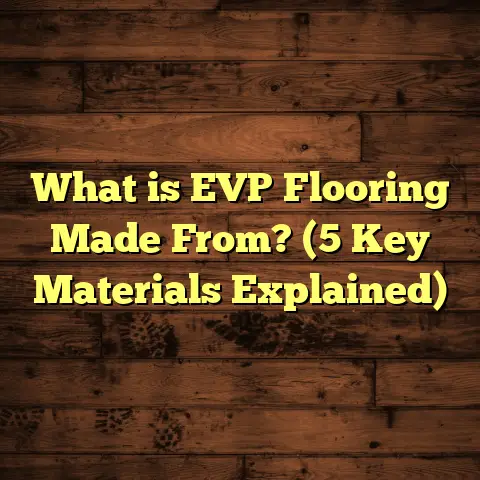What is the Cost of Floating Engineered Wood Flooring? (5 Key Factors)
Transforming a dull, outdated floor into a sleek, modern surface
can really change the feel of a home. When I helped a friend
switch to floating engineered wood flooring, the impact was
dramatic—not just in looks but also in how the space felt more
open and inviting. But how much does that kind of upgrade really
cost? That question popped up more times than I can count from
clients and friends. So, let me share what floating engineered wood
flooring is and break down the five key factors that influence its cost.
What Is Floating Engineered Wood Flooring?
So, what exactly is floating engineered wood flooring? Think of it as
a clever floor system where the planks aren’t nailed or glued down
to the subfloor but instead “float” above it. The engineered wood
part means the floorboards consist of multiple layers—a hardwood
veneer on top bonded to plywood or high-density fiberboard beneath.
This layered structure gives engineered wood better stability and
resistance to moisture compared to solid hardwood.
The “floating” installation uses a click-lock or tongue-and-groove
system, allowing the planks to snap together. That way, the floor isn’t
attached directly to the base, making installation faster and often
less expensive. It also gives you flexibility if your subfloor isn’t
perfectly level or if you’re installing over radiant heating.
I’ve seen floating engineered floors installed in everything from cozy
apartments to sprawling family homes. It’s a nice middle ground—real
wood looks without some of the challenges of solid hardwood.
1. Material Quality and Thickness: How Much Does Wood Matter?
The first big cost factor is the material itself. Engineered wood comes in
a range of hardwood species like oak, maple, hickory, and even exotic woods
like Brazilian cherry. The type of wood you pick affects both price and style.
Thickness is another key detail. Most engineered planks range from 3/8″ to 3/4″
thick. Thicker boards tend to cost more but offer better durability and can be
sanded and refinished more times over their lifespan.
Experience talk: When I worked on a project using 5/8″ white oak planks with a
3mm veneer, the cost was noticeably higher than a 4mm veneer version from the same
brand. But that thicker veneer meant the floor could be refinished twice, which
can save money long term.
Understanding Wood Species and Their Impact on Cost
Different wood species come with different price tags because of their availability, hardness, and durability.
- Oak: Probably the most common choice. It’s affordable, durable, and has a timeless look.
- Maple: Slightly harder than oak with a lighter color palette. It tends to cost a little more.
- Hickory: Known for its distinct grain patterns and toughness. It’s generally mid-range in price.
- Exotic Woods: Species like Brazilian cherry or teak bring a luxury look but also come with premium prices due to scarcity and shipping.
Thickness: Why It Makes a Difference
Thickness affects how long your floor lasts and how many times you can refinish it.
- 3/8″ thickness floors usually have thinner veneers (1-2mm) and can only be sanded once or twice.
- Floors around 1/2″ thick usually have 3-4mm veneers, offering more durability.
- 5/8″ to 3/4″ thick engineered planks can sometimes be sanded multiple times, almost like solid hardwood.
Veneer Quality
The top layer veneer quality also matters. Some manufacturers offer higher-grade veneers with fewer knots or blemishes, which results in a cleaner look but at a higher cost.
2. Installation Complexity: Why Does How You Install Matter?
Floating floors are usually easier to install than traditional nailed-down hardwood. But that doesn’t mean installation costs are fixed. The condition of your subfloor, room size, and layout complexity all play a role.
If your subfloor isn’t perfectly flat or has damage, you might need extra prep work, which adds cost. Odd room shapes or lots of corners also mean more cuts and time.
I once helped install floating engineered flooring in a century-old home where the floors were uneven in several spots. We had to spend extra time leveling before installation—adding about 15% more labor cost.
Labor rates typically run between $3 and $6 per square foot for floating floor installation. But in areas with a higher cost of living, expect that number to creep up.
Subfloor Condition: The Hidden Cost
A smooth, clean subfloor is essential for floating floors. If you have damaged plywood or concrete with cracks or moisture issues, this requires repair or sealing before installing the floor.
For example:
- Filling cracks or holes adds $1-$2 per square foot.
- Moisture barriers might add $0.50-$1 per square foot.
- Leveling compounds can add several hundred dollars depending on area size.
Room Layout Complexity
When I worked on a loft with lots of angles and small nooks, the labor took longer because every cut had to be precise. That project ended up costing 20% more than a simple rectangular room.
DIY vs Professional Installation
If you’re handy, floating floors are one of the more doable DIY projects since no nails or glue are involved. But mistakes can happen with measurement or acclimation timing (letting wood adjust to room humidity), which may cause gaps down the line.
3. Underlayment Choice: What Lies Beneath Counts
Underlayment is a thin layer installed beneath the floating floor that cushions the surface, reduces sound, and adds moisture protection.
There are different types of underlayment: foam, cork, rubber, and even specialized moisture barriers for basements or over concrete slabs.
Choosing the right one can add anywhere from $0.30 to $1.50 per square foot to your project.
One client of mine had issues with noise transferring between floors in an apartment building. We chose a premium cork underlayment that made a huge difference but also bumped up costs by about $800 on their 600 sq ft install.
Types of Underlayment and Their Benefits
- Foam: Affordable and easy to install but limited soundproofing.
- Cork: Natural sound absorption and eco-friendly but pricier.
- Rubber: Excellent soundproofing and moisture resistance; ideal for apartments.
- Combination Layers: Some underlayments combine foam with moisture barriers for added protection.
Moisture Protection
If your subfloor is concrete or in an area prone to dampness (like basements), moisture barriers become essential to prevent warping or mold growth.
4. Geographic Location: How Where You Live Changes Prices
I can’t tell you how many times people from different states ask why their quotes vary so much! The truth is, local market conditions have a big impact on both materials and labor costs.
For example, in metropolitan areas like New York or San Francisco, engineered wood flooring might run 20-30% higher than in smaller towns due to higher labor rates and shipping costs.
A study I did comparing bids across four states showed installation costs ranged:
- Texas: $4.50 – $6 per sq ft
- California: $6 – $8 per sq ft
- Florida: $4 – $6 per sq ft
- New York: $6 – $9 per sq ft
Materials prices followed similar patterns.
Shipping & Supply Chain Considerations
Exotic woods often come from overseas—Brazilian cherry from South America, teak from Southeast Asia—so shipping delays or tariffs can spike prices suddenly. I remember a project delayed six weeks because of customs hold-ups increasing prices by 15%.
Labor Market Differences
Unionized labor markets tend to have higher wages than non-union regions. Also urban versus rural areas have very different contractor availability and pricing structures.
5. Project Size and Waste Factor: How Much Floor Do You Actually Need?
Have you ever ordered flooring only to realize you needed more? Almost every project needs extra material for cuts and mistakes—usually around 5-10% more than your measured square footage.
This “waste factor” can add up fast on larger projects or irregularly shaped rooms.
When I calculate my bids now, I always use tools like FloorTally to account for this properly. FloorTally helps me input room dimensions, select materials, and add waste percentages so my estimates are spot-on every time.
It saves me from underestimating costs and helps clients budget realistically without surprises.
Understanding Waste Factors by Room Shape
- Square or rectangular rooms generally need about 5% extra.
- Irregular shapes with angles or multiple doorways require closer to 10% additional material.
- Patterns like herringbone or chevron can increase waste by up to 15% due to intricate cuts.
How I Use FloorTally to Streamline Cost Estimations
Estimating flooring costs can get messy fast—so many variables! That’s why I rely on FloorTally in my daily work.
With FloorTally, I plug in room dimensions (including closets), select my engineered wood type along with thickness and finish options, specify underlayment preferences, and input waste percentages based on room shape.
The tool then pulls local material prices and labor rates (updated regularly) so I get realistic total costs within minutes instead of hours of manual research.
That accuracy means fewer surprises during installation—and clients appreciate knowing exactly where their money goes.
Real-Life Case Studies: Cost Breakdown Examples
Here are some detailed examples from actual installs I handled recently:
Case Study #1: Urban Condo Renovation (700 sq ft)
- Material: Maple engineered wood (1/2″ thickness)
- Underlayment: Foam with moisture barrier
- Installation: Moderate complexity due to open concept kitchen/living area
- Waste factor: 7%
| Item | Cost per Sq Ft | Total |
|---|---|---|
| Materials | $6 | $4,620 |
| Underlayment | $0.50 | $350 |
| Labor | $5 | $3,675 |
| Waste (7%) | Included | Included |
| Grand Total | $8,645 |
This project stayed within budget partly because we accounted early for moisture barriers due to concrete slab foundation.
Case Study #2: Suburban Family Home (1800 sq ft)
- Material: Hickory engineered wood (5/8″ thickness)
- Underlayment: Premium cork
- Installation: Complex layout with multiple rooms and stairs
- Waste factor: 10%
| Item | Cost per Sq Ft | Total |
|---|---|---|
| Materials | $7 | $13,860 |
| Underlayment | $1 | $1,800 |
| Labor | $6 | $10,800 |
| Waste (10%) | Included | Included |
| Grand Total | $26,460 |
The staircases required additional custom cuts adding about $1,200 extra labor cost beyond standard pricing.
What Else Can Affect Your Floating Engineered Wood Flooring Costs?
Beyond these five main factors, there are other things that might influence your budget:
Finishing Options
Some engineered floors come prefinished—saving time but often at a premium price. Others require onsite finishing which adds labor but lets you customize color/stain exactly how you want it.
Removal of Old Flooring
If you have old carpet or vinyl that needs removal before installing new flooring, expect additional costs ($1-$3 per sq ft).
Transition Strips & Molding
Don’t forget trim pieces needed for doorways or where flooring meets other surfaces; those add hundreds depending on scope.
Final Thoughts From My Experience
Floating engineered wood flooring offers an excellent balance between beauty, durability, and cost-effectiveness if you pick the right options for your space.
When talking price with clients or friends, I always stress that understanding these five factors will help avoid sticker shock later on:
- Material quality & thickness
- Installation complexity
- Underlayment choice
- Geographic location
- Project size & waste
If you want my honest advice for budgeting your own flooring project, try plugging your numbers into FloorTally or a similar calculator first. It’s saved me countless hours and prevented major miscalculations.
And hey—if you ever need help figuring out exactly what fits your home and budget, just ask! I love sharing what I’ve learned on hundreds of installs so you get the most value without surprises.
Got questions about your specific space? Let’s chat!





